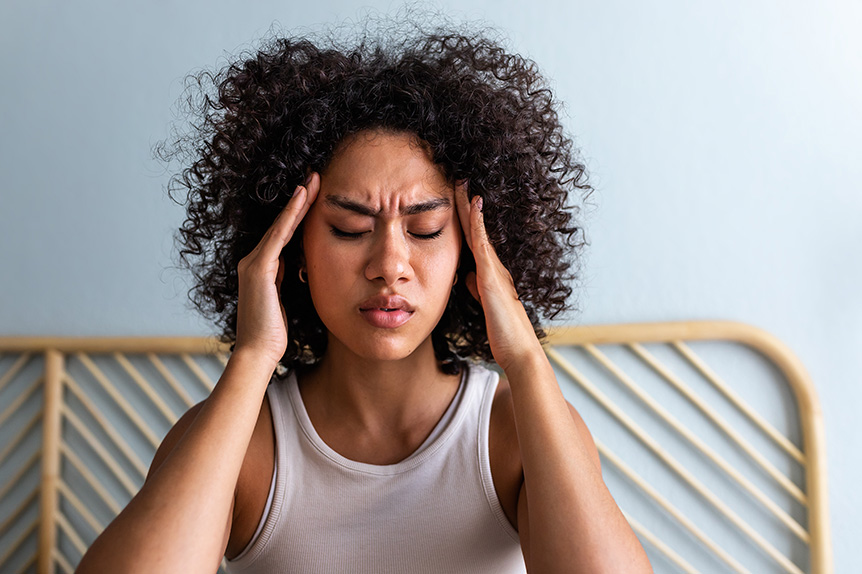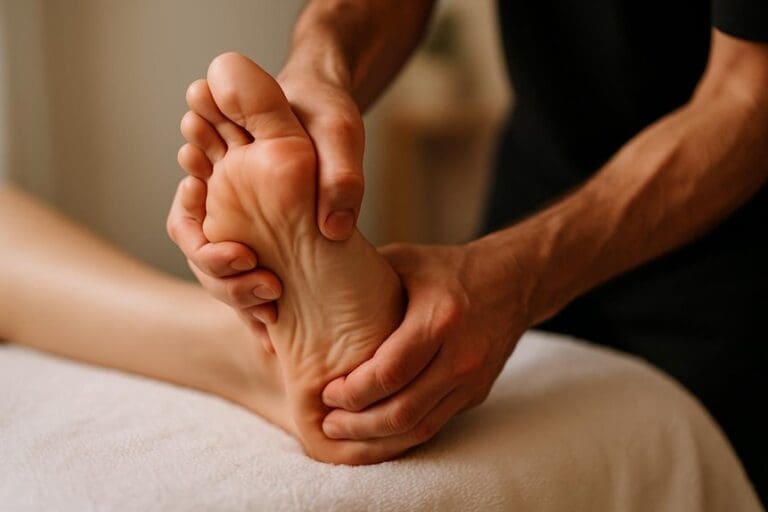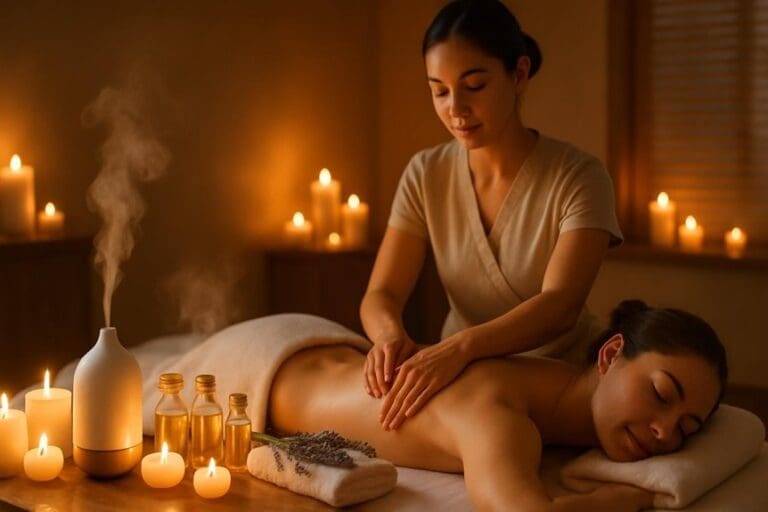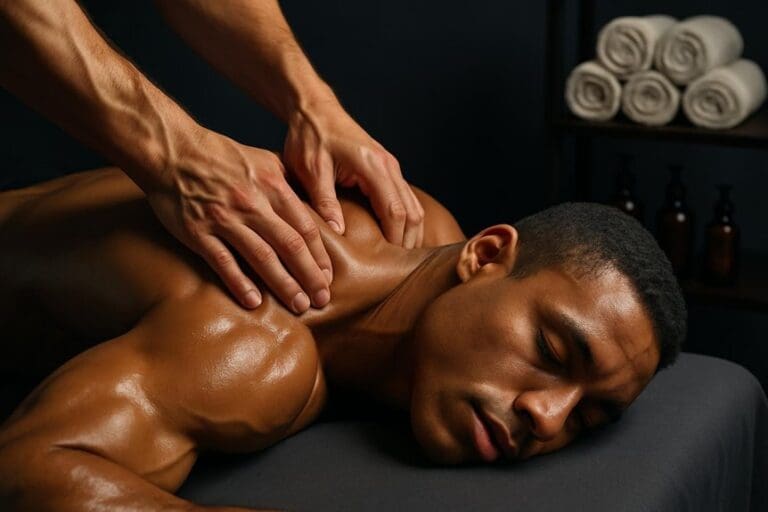Reflex therapy may help some people with migraines by applying precise pressure to foot and hand points linked to cranial, cervical, and autonomic pathways. Proposed mechanisms include modulation of the autonomic nervous system, gate-control of pain, reduced muscle guarding in head–neck regions, and improved circulation. Evidence is modest and low certainty, suggesting it is best used as an adjunct to medical care and lifestyle strategies. Safety screening and tailored pressure are important. Further details clarify techniques, precautions, and integration options.
What Reflexology Is and How It Works
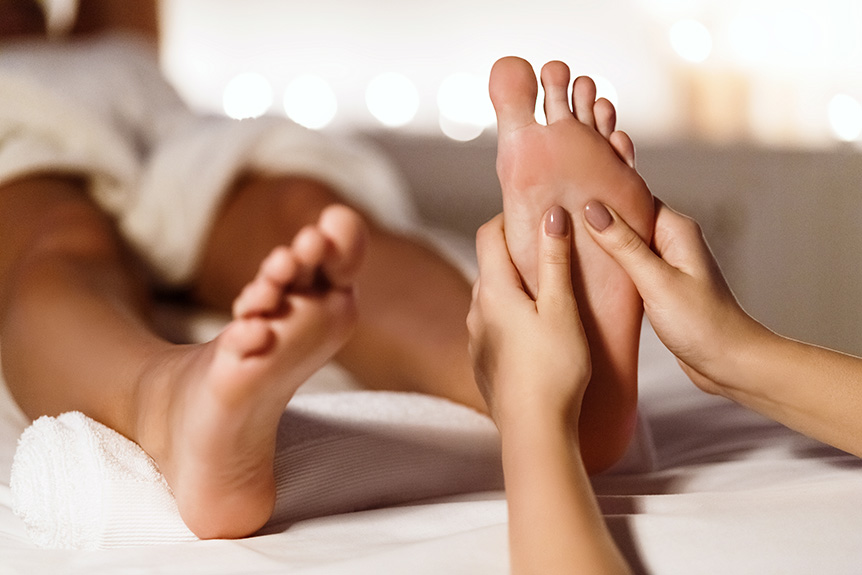
It is a manual therapy that applies targeted pressure to specific points on the feet, hands, or ears that are mapped to corresponding organs and systems of the body. Evidence suggests these stimuli modulate autonomic balance, support peripheral circulation, and influence pain signaling via gate-control and descending inhibitory pathways.
Mechanistically, firm, specific pressure activates mechanoreceptors, dampens sympathetic tone, and may reduce local muscle guarding.
At Spa & Massage clinics in London, therapists perform structured assessments, then apply calibrated thumb-walking, hook-and-backup, and static holds along reflex zones. Hygiene, pressure testing, and client feedback guide intensity to avoid overstimulation.
Sessions typically integrate diaphragmatic breathing cues to enhance vagal activity. Aftercare includes hydration, gentle ankle and toe mobilisations, and monitoring for transient soreness, aligning the experience with calm, attentive care.
It is also recognized for its healing power, as it aims to restore balance and promote wellness throughout the body.
Migraines vs. Headaches: Key Differences
Although both involve head pain, migraines and primary tension-type headaches differ in pathophysiology, symptoms, and impact. Migraines reflect transient brain hypersensitivity and trigeminovascular activation, often driven by cortical spreading depolarisation, neurogenic inflammation, and altered serotonin pathways.
Pain is typically unilateral, throbbing, moderate–severe, worsened by activity, and accompanied by nausea, photophobia, phonophobia, and sometimes aura. Tension-type headaches arise from central pain amplification with peripheral myofascial input.
Pain is bilateral, pressing or tightening, mild–moderate, and not aggravated by routine movement.
Duration and recurrence patterns diverge: migraines cluster in attacks lasting 4–72 hours, while tension-type headaches can be episodic or chronic with longer, dull courses.
In Spa & Massage clinics, therapists assess triggers, posture, and stress load to guide supportive, non-pharmacological care alongside medical management.
Reflex Points Linked to Head and Neck Tension
Several reflex zones are consistently targeted for head and neck tension: the great toe (hallux) for cranial/head regions, the second–fifth toes for sinus/forehead areas, the medial and lateral hallux base for upper cervical junctions, the ball of the foot (metatarsal heads) for neck and shoulder correlates, and the medial longitudinal arch for spinal segments C1–T1.
Practitioners stimulate these areas to modulate nociceptive input, ease myofascial guarding, and encourage autonomic balance.
Gradual thumb-walking and precise hook-and-back techniques are used to locate tenderness, then sustain pressure within a comfortable, slow breath. At Spa & Massage, therapists map these points bilaterally, monitor tissue texture changes, and adjust depth to avoid reactive tightening.
Clients often report a warming release along the suboccipital line, jaw, and upper trapezius as tension eases.
What the Evidence Says About Reflex Therapy for Migraines
How strong is the research base linking foot pressure therapy to migraine relief? Current evidence is modest and heterogeneous.
Small randomized trials and pilot studies suggest that it may reduce attack frequency and perceived intensity compared with light-touch or waitlist controls, but sample sizes are limited, blinding is challenging, and protocols vary.
Proposed mechanisms include modulation of autonomic balance (shifting sympathetic overdrive), improved peripheral circulation, dampening of nociceptive signaling via descending inhibitory pathways, and reduction of stress-mediated trigeminovascular activation.
Systematic reviews rate overall certainty as low to very low due to bias and inconsistency. Yet safety appears favourable with rare adverse effects.
Clinically, it is best positioned as an adjunct to standard migraine care.
At Spa & Massage, this aligns with a cautious, client-centred approach that prioritises measured outcomes and comfort.
How Our Therapists Structure a Massage Session for Migraine Relief
At Spa & Massage, therapists prioritise targeted foot reflex points linked to the head, neck, autonomic regulation, and sinus pathways to modulate nociceptive input and vascular tone relevant to migraine.
Sessions follow a structured flow: brief assessment, precise pressure sequencing on mapped zones, and measured progression from parasympathetic downregulation to symptom-specific work.
Aftercare focuses on hydration, gentle cervical mobility, and trigger tracking, with guidance on frequency and home acupressure to reinforce clinical effects.
Targeted Foot Reflex Points
Before applying pressure, a therapist conducts a brief assessment to map headache patterns, then structures the massage session around foot points linked to cranial, cervical, and autonomic pathways.
In Spa & Massage clinics, attention typically centres on the hallux apex (cranial/forehead reflex), hallux base and medial neck line (upper cervical), the solar plexus point in the medial arch, and the pituitary reflex at the hallux center.
Mechanistically, stimulation aims to modulate trigeminovascular drive, ease cervical myofascial tension, and downshift sympathetic arousal.
For photophobia and temporal pain, the lateral hallux and second toe margins are prioritised; for occipital or neck-linked migraines, the medial heel-calcaneal border is emphasised.
Gentle, sustained pressure is alternated with precise thumb walks to monitor tenderness gradients and promote a parasympathetic, steadier vascular tone.
Session Flow and Aftercare
Building on the mapped reflex points, each migraine-focused session at Spa & Massage follows a standardized arc: brief symptom check and contraindication screen; baseline pain, light/sound sensitivity, and neck stiffness scoring; foot warm-up to enhance peripheral perfusion; targeted sequencing of cranial, cervical, and autonomic reflexes; and a short reassessment.
Pressure is titrated to client feedback, prioritizing parasympathetic predominance via slow, sustained holds and diaphragmatic pacing cues. Techniques aim to modulate trigeminovascular excitability, reduce cervical myofascial tone via reflex loops, and downshift hypothalamic–pituitary–adrenal arousal.
Aftercare reinforces these mechanisms: two large glasses of water over six hours, gentle neck range-of-motion mobilizations, dim-light recovery for 20–30 minutes, and avoidance of alcohol and intense exercise for the day. Therapists advise documenting aura, triggers, sleep, and analgesic use to refine session parameters.
At-Home Zone Therapy Techniques Between Appointments
While professional therapist provides the primary therapeutic stimulus, brief, structured self-care between appointments can help modulate nociceptive input and autonomic tone relevant to migraine.
Spa & Massage advises clients to target foot reflex zones linked to cranial innervation: gentle circular pressure to the great toe pads (hallux) for 60–90 seconds per side, then slow thumb-walking along the medial longitudinal arch to influence parasympathetic balance.
Consistent, low-load pressure reduces peripheral sensitisation and may downshift sympathetic arousal.
A warm foot soak followed by a pea-sized amount of neutral, unscented oil—as used in our clinics—improves glide and sensory comfort.
Breathing at five to six cycles per minute during techniques augments vagal engagement.
Frequency: one to two short sessions daily, especially at prodromal hints (neck tightness, photophobia).
Document triggers and responses to refine therapist-guided care.
Safety, Contraindications, and When to Seek Medical Care
It is generally well tolerated, but it should be avoided or deferred in cases of acute DVT, uncontrolled hypertension, active infection or fever, recent fractures or surgery of the feet/ankles, severe peripheral neuropathy, and during high-risk pregnancy without medical clearance.
Mechanistically, firm pressure can transiently alter autonomic tone and local circulation, so individuals on anticoagulants, with bleeding disorders, or significant vascular disease warrant caution and modified techniques—our therapists screen for these factors before sessions.
Medical care should be sought for first or “worst-ever” headache, sudden neurologic deficits, head trauma, persistent vomiting, new-onset headache after age 50, escalating frequency or severity despite care, or migraine accompanied by fever, neck stiffness, vision loss, or jaw claudication.
Who Should Avoid This Therapy
Several clinical scenarios warrant caution or temporary avoidance of this therapy, because pressure to the feet, hands, or ears can alter local circulation, stimulate autonomic responses, or provoke discomfort in vulnerable tissues.
Individuals with acute deep vein thrombosis, severe peripheral vascular disease, active infections or cellulitis of the feet or hands, unhealed wounds, recent fractures, or significant neuropathy should defer treatment.
Uncontrolled hypertension, unstable cardiac disease, or syncope history may be destabilized by autonomic shifts.
Those with bleeding disorders, low platelets, or anticoagulant therapy risk bruising.
Pregnancy in the first trimester, high-risk pregnancies, or recent pregnancy complications warrant obstetric clearance.
Postoperative states and recent sprains benefit from rest until inflammation subsides.
At Spa & Massage, therapists screen thoroughly, adapt pressure, and prioritise client safety.
Signs to Seek Medical Care
When should a client pause this and contact a clinician? If a “migraine” is sudden and maximal at onset (thunderclap), follows head injury, or is accompanied by fever, stiff neck, confusion, fainting, weakness, vision loss, or new speech difficulty, urgent medical assessment is advised.
Escalating headache frequency, new-onset migraine after age 50, or headaches that wake them from sleep also warrant evaluation. Persistent vomiting, pregnancy with severe headache, or headaches triggered by exertion or sexual activity should be reviewed medically.
From Spa & Massage’s perspective, it is supportive, not diagnostic. If foot or hand work provokes atypical neurological symptoms, severe dizziness, or chest pain, sessions are paused and referral is encouraged.
Clients on anticoagulants, with uncontrolled hypertension, or active infection should seek clinician guidance before continuing this therapy.
Integrating It With Massage and Lifestyle Strategies
How can targeted foot reflex points be combined with structured massage and daily habits to reduce migraine frequency and intensity?
Spa & Massage recommends a pragmatic blend: zone therapy to modulate autonomic tone, deep tissue or sports massage to release myofascial trigger points in the neck and shoulders, and aromatherapy to influence limbic pathways.
Evidence links cervical muscle tension, sleep irregularity, and dehydration to migraine sensitisation.
In sessions, therapists prioritise reflex points mapped to the head, neck, and solar plexus, then address suboccipital and trapezial tension with measured pressure and slow strokes.
At home, clients track triggers, hydrate, maintain consistent sleep, and perform gentle cervical mobility.
Therapists suggest magnesium-rich nutrition, brief breathwork, and post-session heat or cold packs to temper nociceptive input.
Conclusion
It sits between promise and proof: measurable autonomic calming, improved peripheral circulation, and reduced muscle guarding contrasted with limited, small-scale trials. For migraineurs, precise foot and hand point work offers downshifted arousal and eased cervico-trigeminal tension, yet it is adjunct, not cure. When paired with medical care, massage, sleep hygiene, hydration, and trigger management, sessions may lower frequency and intensity. Red flags still mandate urgent review. Relief is plausible through mechanisms; durability depends on personalised, evidence-aligned integration.
